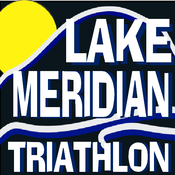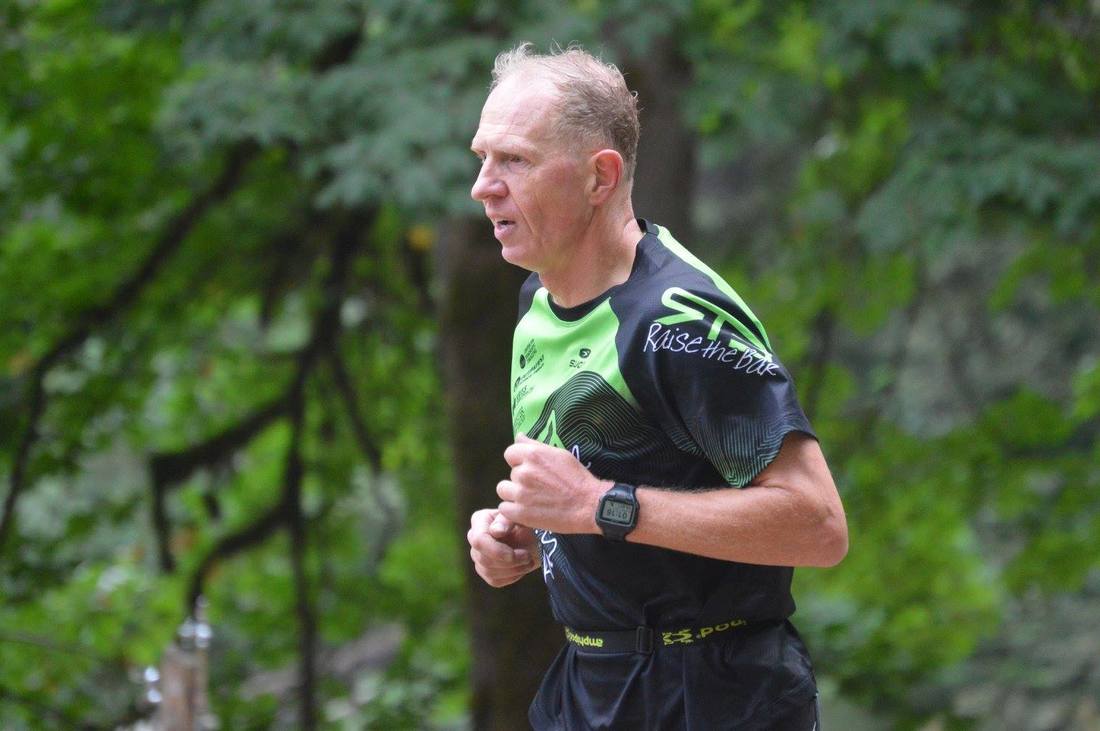 by Lance Hester In the legal business, we use the word “damages” to talk about the bad stuff our clients go through. There are two kinds of damages. The first is what we refer to interchangeably as “special” damages or “economic” damages. The second is called “general” damages. Here’s the basic idea: The expenses of getting hurt are the “special” or “economic” damages. For example, injured cyclists, pedestrians, swimmers, and drivers incur expenses that add up quickly – ambulance rides, hospital bills, doctor bills, physical therapy, and lost wages. “General damages” is the more subjective number associated with the pain, suffering, recovery time, and hassle involved in recovering from being injured. Here’s a very general guide to the resources available when you’ve been injured by another’s negligence, and ways to protect yourself when the bad driver doesn’t have enough to cover your costs. All too many drivers carry only the minimum required coverage of $25,000 to cover the special and general damages involved in these kinds of cases. As you can imagine, even a minor collision can exceed $25,000 in medical bills during an ER. On behalf of our clients we have to examine whether other sources exist that can help their claims. These include the following: UIM/UM Coverage (Un or Under-insured motorist coverage), PIP (Personal Injury Protection) and Homeowners coverage. Ensuring medical expenses are covered is the most important initial objective after a collision. Every cyclist is well advised to have good health insurance and Personal Injury Protection (PIP coverage). PIP can cover medical expenses, but unlike health insurance it can cover services and lost wages. In Washington PIP coverage is optional coverage on your automobile policy, but we always recommend electing as much PIP as you can afford. If you are in a cycling accident caused by an automobile driver, there is a chance that the driver’s PIP coverage and your own PIP coverage can be combined for double the coverage. The point is that a bad injury may leave you needing lost wages and services covered. And if you don’t need those services, the PIP coverage will cover your medical expenses before your health insurance is tapped. PIP coverage is available while the case is pending. While a case normally settles once and for all at the end of the healing time, PIP is accessible in the interim, which is particularly helpful for those who, perhaps, lack health insurance. UM/UIM coverage is something every cyclist should carry. Every day we see cases with substantial injuries and ultimately learn that the at-fault driver carried only $25,000 in insurance (or worse, was uninsured). This is your chance to be prepared for the worst. Further, if you carry the maximum amount your carrier offers, some carriers offer umbrella UM/UIM coverage which can give you and the rest of your household the most confidence you’ll be made closer to whole when the whole case concludes. Homeowners coverage is a frequently used when other specific policies don’t apply. Homeowners is not likely to help when there is a vehicle involved. But it is available in the unusual, but not unheard-of, scenario of a cyclist causing another cyclist or a pedestrian’s injuries. And, as mentioned, if you have enough bodily injury coverage on your homeowners, you’ll be eligible to own an umbrella, which will raise all of your coverage amounts to the amount of your umbrella, usually $1 million or $2 million. Because injuries are expensive, and because it’s hard to put a value on pain and recovery, cycling, pedestrian/runner, and automobile injury claims take a lot of capital to cover. At times we have to explore everything possible available to help make our clients whole. And sometimes it means tapping into their own insurance policies. You never know whether the people who might cause you pain will be adequately insured. The best way you can be prepared is to have the most PIP, UM/UIM, and Homeowners coverage you can afford. I haven’t begun to address what to do if the government, for example, might be responsible for things like failing to replace a drain cover or cracks in the sidewalk. One of us will cover that in a future article.
0 Comments
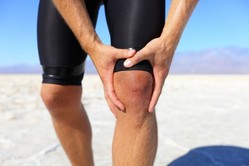 By Holly Pennington, PT, DPT/Outpatient Physical Therapy You went to the doctor for your knee pain (finally!) After a clinical exam, x-rays and an MRI, she concluded your symptoms are due to the arthritic changes in your knee. You recall your doctor using phrases like “wear-and-tear” and “bone-on-bone” as she explained how the cushioning between your knee bones has thinned and is now unable to absorb the shock it once did. Her diagnosis of knee osteoarthritis (OA) validates your symptoms - the stiffness you feel in the morning, pain with running, and the creaking sound when you bend and straighten your knee. When she pointed to the thin gray line denoting the barely-there space between the joints on your x-ray, then contrasted it with the thick black space of a “normal” knee, your fear of never being able to run again set in. Now, it’s a month later. You have been taking the Naproxen your doctor prescribed and you’ve upped your stretching game. You’re trying more cycling and less running. You are living in that confusing space where your pain isn’t “bad enough” for surgery or another visit to the doctor, but - if you’re honest with yourself – your knee symptoms are not improving. Now what? Before I answer that, let’s clear up common misconceptions about osteoarthritis (OA) that might be doing you more harm than good. Most importantly, you can stop blaming yourself: those years of carrying extra weight around, the miles you’ve been logging despite your knee pain. They didn’t cause your OA. In fact, you can thank three things you can’t control for your knee pain: your relatives, gender and age. Knee OA is more common in women than men, and cartilage loses its ability to heal with age. Your genes shaped your bones and cartilage in ways that make them susceptible to arthritis – or resistant to it – without your permission. Now that you can be nice to yourself, let’s talk about what steps you can take to help that nagging knee pain. Surgery is not your only - or best - option. In fact, numerous recent studies report that surgical outcomes for knee OA are not better than placebo or nonsurgical treatments. Throw in the fact that high percentages of incidental findings on imaging studies such as CT scans, x-rays and MRI’s are incorrectly correlated to symptoms, and you can stop worrying about your surgical insurance coverage right now. Your best course of action? Exercise. I know, I know. Your eyes are rolling. You’re a triathlete. Exercise is in your blood. You were hoping for something more progressive and exciting. But, experts repetitively conclude that exercise is the best non-drug treatment for OA. In fact, in a study including over 2,600 participants there was no significant difference in the prevalence of symptomatic knee OA in runners compared to nonrunners. So, what about the fact that running hurts? Aren’t you going to cause more damage to the joint? Surprisingly, the answer is “no.” Stronger muscles will do the work that your thinning cartilage can’t: shock absorption. For exercise to reduce your knee pain, you must do more than swim, bike and run. An effective OA exercise treatment program must include strengthening. Stronger quads, hamstrings and hip muscles will result in less stress on what’s left of the cartilage in your knee. All that aerobic exercise keeps you fit, but it’s not building muscle strength. Your OA diagnosis does not mean surgery, no more running, or the end of your triathlon career. Your Physical Therapist can help you make important, intentional changes to your training program to put you in charge of your symptoms for the long haul, and return to racing pain free. With 7 convenient locations including Kent, Covington, Maple Valley, Auburn and Puyallup, Physical Therapists at Outpatient PT can keep you racing by prescribing a safe and effective strengthening program for arthritis. Schedule a free consult at the location nearest you: www.outpatientpt.com 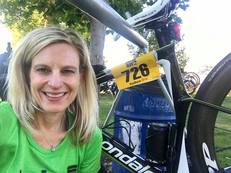 Why do I Tri? Because I can. I want to be a good role model for my daughter. The challenges inspire me to be my best. The people I have met doing triathlon inspire me every day, touch my heart and also happen to be some of the best people I have ever known. Because of RTB. I could end here, but I am guessing when Kathy asked me to do it she was expecting more of a story. So here it goes… It’s funny, over the course of the last several years I have asked myself Why I Tri and I keep adding reasons. As mom of a 2 year old at the age of 39, I did my first sprint at the Subaru all women’s triathlon at Steele Lake in 2006. I had no idea what I was doing! The first friend I met when I moved to WA in 1997 from a local running group had started doing triathlons and she talked me into giving it a go. Why not? I had a 2 year old now and I probably needed to try something new. “Training" consisted of her having me set up a transition area with all the borrowed items in my driveway and pretending to transition! I was very weary of all the steps to triathlon (versus a marathon and just running)… and sometimes that is true still to this day! A day after I finished, another good running friend reminded me that she had convinced me to sign up to do the Black Diamond sprint - I thought I must have been crazy because two in two weeks when I didn't know what I was doing was just too much! Then and to this day, friends are the secret sauce that make it happen. I did have my helmet on backwards for that Black Diamond bike leg, and oh my it took a long time to live that down! In 2006 my husband also did his first triathlon, except he chose to do Ironman CDA - and after training with 4 OWS, he was swimming, and completed it in 11:01, narrowly missing a Kona spot. Totally different approaches to trying a triathlon!  First Triathlon First Triathlon So that’s how it began. My friend believed I could. And to be honest, that is how I continue to set and reach new goals all the time - thanks to the awesome friends I’ve made on the RTB team. Soon after those first triathlons things changed. In 2007, my long time running goal of going to Boston was a reality. After years of trying to qualify and be that runner - which I started at the age of 29 in 1996 - I finally made it. My husband ran it with me, as he had promised for years he would when I qualified. For him, every marathon was a BQ. For me, it was a long journey. To be sure, running it with me was an easy training run for him! And then it happened. A week or so after we got back from Boston, while he was helping a contractor take down a tree in our yard, in a freak second he crushed his ankle beyond repair. Just like that, it was the end of his marathon and ultra-running days. He didn’t walk for several months and after a few surgeries over two years and a lot of pain he got back to cycling - his first love - but running was not an option. Everything changed for him and me as well. A new lens to look through. What next? 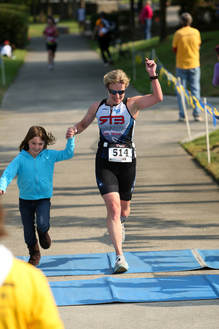 Lake Meridian Finish 2012 Lake Meridian Finish 2012 At that point, our running group we met with several times a week began falling apart too - age, injuries, family stuff - you name it. So, I decided to do that Tri thing again. I heard of the Lake Meridian triathlon from a very close friend I knew from running. She was a marathon maniac and always in top shape. She did the Lake Meridian Tri and told me the Olympic distance wasn’t that bad. So off I went - and on the way heard there was this team that put it together... Just like that, RTB became the reason I did triathlons. They were the best group of people and I fell in love! I did another Olympic or two and trained with the team. They showed me the ropes, didn't laugh at my blunders and were the family of friends that I'd lost in my running group and I'd been missing. Tom and Diana Hull got me out training and kept me smiling. So many bike rides with those two and it was a blast. Vince and his family quickly became some of my favorite people showing us the ropes in Chelan. He gave me countless transition tips - as he is a transition ninja - and let's just say I'm still working on those! Ericka kept me laughing and training, she made it super fun. It wasn't long before someone convinced me to try doing a half iron. I thought hmm, I better get a coach for that. Kathy stepped in, propped me up and got me acquainted with HR monitors and a real training plan. Best of all, lucky me I met my beloved birthday twin Jenn McCormick! She was also training for her first half with Kathy. Countless hours on the road and trails and in the water and it was the best time I'd ever had training. Getting to know such an awesome person who happens to be my birthday twin felt like destiny, divine intervention you name it - something fantastic! We were alike in so many ways and lucky for me she was different too….she became the map master for our rides, the calm voice when the tire went flat and the McGyver who could fix anything in seconds flat! 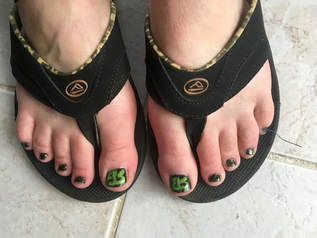 RTB Toes RTB Toes Over the years I got to know Dagmar, Wendy, Tammy, Debbie, Joy, Kelly, Cindy, Denise, Tess, Deborah, Lisa, Jenn Schroeder and so many more awesome people. Soon I was doing another half iron, training with amazing Alissa. She worked me hard, saw me through ups and downs of all kinds and believed in me no matter what. I met miss Katie Thompson who was so fun to work out with, and so inspiring. She was training herself for her first iron man and the desire to go to Kona put a sparkle in her eye. I am old enough to be her mother, and I grew to love her like she was my own. With RTB, the support and fun was endless. The circle kept growing... friends, the secret sauce! Who would've thought I'd be spending my weekend winter mornings in a pool and then with the garage gang riding on trainers for hours? Ray & Ryan letting us converge on their garages, Denny feeding us donuts and brightening up the dark winter days while Debbie, Kelly and I chatted and sweat, getting it done. Wendy deciding to go for Boston and train with me away from her beloved mountains with me because at 50 I wanted to BQ again. Convincing me after 8 years of NOT running marathons I could do marathons again and qualify. Katie deciding to run with me to pace me at attempt #2, what become my second BQ, even though her foot hurt from doing her second Ironman just weeks before. Tess, after my bike crash at mile 31 in CDA telling me in transition when I stood there confused, you can do it, just put the bike up it's ok. Val, picking me up 2 miles from the finish at CDA 70.3, and deciding she was going to walk with me and sacrifice her own race because as she said "I don't have anywhere to be and you've got a race to finish". Michelle taking care of me and making sure I am taking care of myself which isn’t always the top of my list. Quality humans, all of the them. The friendships I have made and the support from the team has kept me going, kept me in the sport and believing I can do whatever it is I'm trying to do - triathlon, running, anything in life. One of the greatest things about doing triathlons has been having my daughter see me do them, the successes (and the failures) and all the while her being my biggest cheerleader no matter what. When she crossed the Lake Meridian triathlon with me for that first Olympic race, it was the best moment of the whole race. She ran with me to the finish in her Ugg boots holding my hand and I felt like I had won the race! I've seen so many on the team be the best role models for their children and I strive to do the same. It's priceless when she says I'm so proud of you mom on the good days and the bad. What has been most challenging? The dark moments when you doubt, when you've had a bike crash in your A race, some crazy health thing bringing you to a stand still when you are trying to BQ again at 50, battling with the race nutrition gods and trying to come out on top...missing a race goal and then barely being able to finish at all - tough stuff. Everyone has a story, the good, the bad and everything in between. What do I tell myself or do to keep on going in those dark moments? I'm so blessed, I love this. The secret to enduring is enjoying, crack a smile. Everyone in this race is trying to get from point A to point B on their own journey. I am stronger than I know. And in purple sharpie on my hand where I can always see it during a race - FUN! There have been ups and downs of course as with everything. Injuries here and there that kept me from running or swimming, health issues I didn't know I had, races that didn’t go well at all, races I had to dig deep to not quit, work & family schedules that made training tough. I need to Tri to prove to myself I can do it when I think I can't. I could sit around and eat peanut butter straight from the jar and cry when I can't seem to get it together (and sometimes I do) but in spite of it all, the training, team and triathlon goals have been the glue that has kept me together on more than one occasion. I get so much from it and hopefully give back as much as I receive. Why do I Tri? Because of the people and RTB. BETTER TOGETHER. |
Raise the BarRace reports, upcoming events, news, and more, from RTB. Archives
September 2023
|


 RSS Feed
RSS Feed
